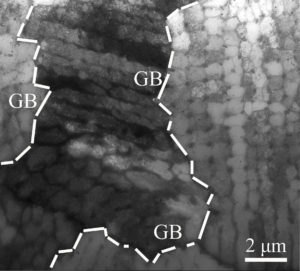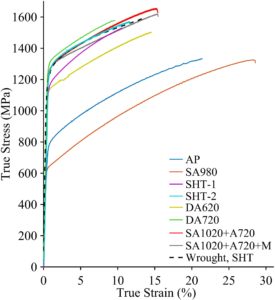Research on process–structure–property relationships tied to earliest questions when ADAPT consortium formed
Update to original post: Additive Manufacturing published the article in January, 2020: https://doi.org/10.1016/j.addma.2019.100977
A research paper on ADAPT-led investigations into heat treating additively manufactured Inconel 718 parts is in revision with the journal Additive Manufacturing and is available as a preprint via Arxiv.
“Knowledge of Process–Structure–Property Relationships to Engineer Better Heat Treatments for Laser Powder Bed Fusion Additive Manufactured Inconel 718” documents work done by Thomas G. Gallmeyer, Senthamilaruvi Moorthy, Branden B. Kappes, Michael J. Mills, Behnam Amin-Ahmadi and Aaron P. Stebner.
 ADAPT Executive Director Aaron Stebner recalled how this research started: “When ADAPT began in 2016, one of the first big questions from our members was, ‘Are we heat treating parts the right way?’ Generally, standards in industry at that time recommended that additive Inconel 718 parts should be heat treated the same way as traditionally manufactured parts.”
ADAPT Executive Director Aaron Stebner recalled how this research started: “When ADAPT began in 2016, one of the first big questions from our members was, ‘Are we heat treating parts the right way?’ Generally, standards in industry at that time recommended that additive Inconel 718 parts should be heat treated the same way as traditionally manufactured parts.”
Then, in 2017, researchers from Lawrence Livermore National Laboratory published research that indicated that additively manufactured 316L stainless steels could perform better than traditionally manufactured materials. Their 2018 article in Nature Materials, “Additively Manufactured Hierarchical Stainless Steels with High Strength and Ductility,” documented that the dislocation cells that result from the AM process augment grain structures and result in improved strength and ductility.
“We knew the same dislocation cells form in additively manufactured Inconel 718,” said Stebner. “But you don’t have to heat treat 316 stainless steel, and after heat treating Inconel parts the usual way, those dislocation cells were no longer there. Heat treating Inconel 718 the same way as traditionally manufactured parts removed the dislocation cells and the benefits they provided, even as it precipitated out secondary phases that enhanced high-temperature strength.”
The question became: Can we heat treat Inconel 718 in a way that retains the dislocation cells and still precipitates out secondary phases to improve strength and ductility? And how?

“The answer is, yes,” said Stebner. “We can do it, and we get better strength and ductility compared to both AM and forged parts heat treated the traditional way using a nominal, slightly cooler heat treatment approach.” This work also explains a German research team’s previous findings of better high-temperature creep performances in additively manufactured Inconel 718 using slightly modified heat treatments.
In the next phase of this work, ADAPT will examine if the low-cycle fatigue operating temperatures of Inconel 718 parts can be increased as a result of this new knowledge. If it could, Inconel 718—which is known to be easier to process than other higher temperature nickel-based alloys and is less expensive—would be used in more applications. For example, Inconel 718 parts made using AM and heat treated in this new way can be used closer to the core of turbine engines because they can better withstand the stresses of that location.
Another finding will likely tie into Metallurgical and Materials Engineering Associate Professor Jeff King’s research on how radiation affects AM parts. Since nuclear operations are at high temperatures—around 500–600 °C, right at the upper temperature limit of Inconel 718—enabling Inconel to operate at 650 °C “will be a big win for nuclear applications,” said Stebner. “There is also an opportunity to look at radiation and elevated temperature and how the combination of both impacts the strength and lifespan of AM parts.”
An important part of this research was the collaboration with The Ohio State University to look at sample material from additively manufactured Inconel parts on a special electron microscope in Columbus. That device allowed Behnam Amin-Ahmadi to see some of the effects the modified heat treatment has at the atomic scale. “We don’t have a microscope that is aberration-corrected and capable of seeing the aluminum/niobium co-precipitate that adds strength even at high operating temperatures,” noted Amin-Ahmadi. “Fortunately, we were able to use the state-of-the-art microscope on campus in Columbus to see those formations within the AM structure. We’re grateful to our colleague Michael J. Mills at Ohio State for that access.”
